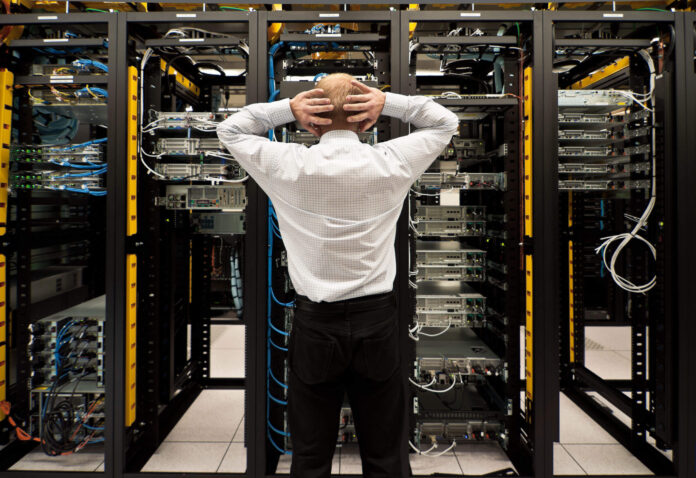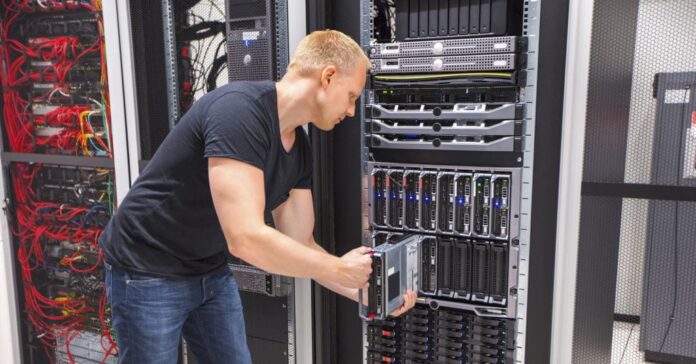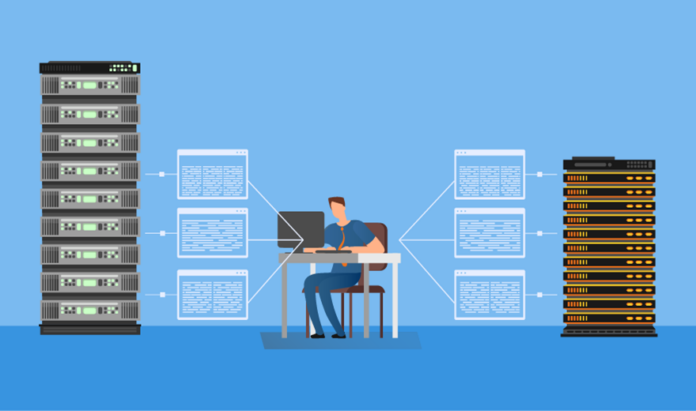The choice of the right hardware for your IT system is vital since devices of different power capacities, processing possibilities, and energy consumption are found on the market. Thus, selecting an appropriate device influences an uninterruptible and continuous work of an entire system. Thus, system administrators should clearly understand the difference between different categories of servers, their advantages, and the peculiarities of work. Below, we’re going to have a deeper look at rack and tower servers, compare them, and outline key differences.
Rack Server: Essence, Features, and Advantages

This type of hardware is called by the name of the furniture in which it is stored. This group of equipment is more compact and stored in racks, these are special cabinets with open frames. Servers are attached to vertical uprights and used for the continuous storage of IT hardware. Such furniture pieces must comply with IEEE standards to accommodate the hardware.
The size of furniture models differs greatly to meet the demands of modern infrastructures. Depending on the number of servers to be accommodated, furniture size is chosen. Racks are ideal for small premises and mid-size companies for storing all equipment ergonomically in one place.
Key Peculiarities of Rack Servers
1. Cost
The price for this hardware usually runs higher since more pieces are required. Businesses frequently have 20 or even more servers to process data and manage tasks. Moreover, due to increasing capabilities, users face the need to buy additional equipment and constantly augment the number of devices.
2. Maintenance
Servers are stored together with other hardware and accessories in one rack. Being a pro in terms of ergonomics, this feature has a drawback as well. The need to use cooling systems to prevent overheating and hardware damage arises. Thus, in addition to active IT infrastructure, fans and sensors are installed in racks to create the required climatic conditions and monitor indicators.
Furniture configuration is not favorable for easy and quick hardware upgrade and replacement due to the high density of equipment.
Rack devices consume a lot of power during a performance, meaning that a business’s energy costs will augment along with adding new equipment.
This type of server can result in time-consuming troubleshooting when technicians try to identify and cure the source of a problem.
3. Application
This type of hardware can cope with a wide range of business tasks. Servers can be configured to process databases, manage email communication, or be responsible for high-end applications. Undisputable benefits of such products include more extensive storage space and high processing power.
Tower Server: Core, Peculiarities, and Benefits

This category of equipment is characterized by bulkier designs. They are usually stored on their own in separate cabinets or on tables as desktop computers. Their design feature makes it impossible to stack one piece on top of one another.
However, modern manufacturers produce special furniture for tower server storage. If you need a server tower cabinet, visit the Sysracks website. Here, highly-functional and ergonomic models are offered. Skilled managers are ready to consult and assist in choosing the best model.
Key Features of Tower Servers
1. Cost
Tower hardware price is lower since devices are used for basic levels of functioning. Higher-priced models can cope with a wider range of tasks and support high-degree applications.
2. Maintenance
Tower equipment requires individual KVM tools (keyboard, mouse, and video) for management.
Cabling is more challenging since connected devices are not located nearby and wires can stretch throughout entire rooms. Yet, this disadvantage has a pro in terms of cooling. Due to individual location, hardware perfectly copes with cooling without the need to install fans.
When maintaining tower equipment, it is easier to locate the source of an issue.
4. Application
This class of hardware can serve both general purposes and specific tasks. It is possible to configure servers to process web, communication, or general information. Note that trying to customize such equipment for more high-end tasks by adding additional devices will lead to more expenses.
Tower VS Rack Hardware: Comparison

To summarize which one is better, let’s make a comparative analysis and highlight the pros and cons of both categories of equipment.
1. Cost
Rack equipment is higher in price than computer server tower models.
2. Accommodation
Rack devices are more compact, while towers are much bulkier. The first category is easily stacked, while the latter one is not suitable for stacking on top of one another. In most cases, tower devices are located separately, while rack models are mounted in special cabinets together with supplementary equipment. Still, a server tower rack is also produced nowadays on the market.
Rack models are more favorable for space-saving and provide better ergonomics. Thus, they are preferable for small premises and limited spaces. Also, there are wall-mount models of furniture so it is possible to locate rack servers on vertical surfaces without occupying floor space.
3. Cooling
Rack servers heat well due to compact placement with other devices and heat exchange. Thus, forced cooling strategies are applied to create an optimal environment and maintain the required conditions. If rack devices are not cooled down, overheating is inevitable.
Tower hardware does not need forced cooling since the device perfectly copes with self-cooling.
4. Business needs
Rack models are an ideal choice for small and mid-size businesses where few servers are required, while tower products are more appropriate for large-scale enterprises.
However, rack devices are multifunctional and characterized by a larger amount of processing power out of the box. Devices can support high-end infrastructure needs and business applications, while tower servers come with minimal configuration requirements.
5. Maintenance and repairs
Rack servers are housed in multi-tier furniture with dozens of other hardware pieces, cables, and accessories. Thus, it is rather problematic to reach the needed equipment for maintenance or replacement.
Tower products feature easier maintenance and repairs. The staff does not face trouble when it is necessary to locate devices, make repairs, and perform upgrades.
To draw the line, note that each category of servers has its field of application. Otherwise, they wouldn’t be produced. Depending on the size of the business, processing volumes, tasks, and available premises, users should select suitable types of equipment.









